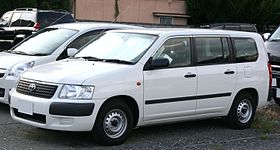Toyota Succeed
This article needs additional citations for verification. (May 2016) |
You can help expand this article with text translated from the corresponding article in Japanese. (September 2012) Click [show] for important translation instructions.
|
| Toyota Succeed (XP50/160) | |
|---|---|
 Toyota Succeed Van UL (NCP51V) | |
| Overview | |
| Manufacturer | Daihatsu[1] |
| Also called |
|
| Production |
|
| Assembly | Japan: Ōyamazaki, Kyoto (Daihatsu Kyoto plant)[1] |
| Body and chassis | |
| Class |
|
| Body style | 5-door station wagon/van |
| Layout | |
| Platform | Toyota NBC platform (2002–2014) Toyota B platform (2014–2020) |
| Related | |
| Powertrain | |
| Engine | |
| Transmission | |
| Dimensions | |
| Wheelbase | 2,550 mm (100.4 in) (X50/160) |
| Length | 4,300 mm (169.3 in) (XP50) 4,245 mm (167.1 in) (XP160) |
| Width | 1,690–1,695 mm (66.5–66.7 in) (XP50/160) |
| Height | 1,510–1,515 mm (59.4–59.6 in) (XP50) 1,525–1,530 mm (60.0–60.2 in) (XP160) |
| Curb weight | 1,050–1,140 kg (2,314.9–2,513.3 lb) (XP50) 1,100–1,170 kg (2,425.1–2,579.4 lb) (XP160) |
| Chronology | |
| Predecessor | Toyota Caldina Van (T190) |
| Successor | Toyota Probox (Succeed Van) Toyota Corolla Fielder (Succeed Wagon) |
The Toyota Succeed is a now-discontinued station wagon/van sold by Toyota in Japan as passenger car[3] and commercial van.[4]
First generation (XP50)
[edit]The first Succeed was introduced in July 2002 as the successor of Toyota Caldina Van.[1] A more basic and shorter version is known as the Toyota Probox.
For 2007 Japanese models, G-Book, a subscription telematics service, was offered as an option.
2014 facelift (XP160)
[edit]Since the 2014 facelift, the Succeed and Probox are identical. However, the Probox is also available with a 1.3-litre engine.[5] The passenger variants of the two were discontinued and the role was taken over by Toyota Corolla Fielder Wagon. The Succeed was available through Toyota and Toyopet dealerships,[6] while the Probox was sold through Corolla dealerships.[7] Starting in 2018, Toyota Japan started merging its four dealership formulas,[8] and the twinned model lines.[9] In May 2020, the Succeed was discontinued.

References
[edit]- ^ a b c "75 Years of Toyota: Toyota Succeed Van (XP50)". www.toyota-global.com.
- ^ "名門車続々生産終了へ…トヨタ大規模車種整理で消えゆく商用車たち". 28 May 2020.
- ^ Succeed wagon Archived 2007-02-22 at the Wayback Machine
- ^ Succeed van Archived 2007-02-22 at the Wayback Machine
- ^ Radu, Mihnea (2014-08-06). "Toyota Launches New 2014 PROBOX and Succeed in Japan". autoevolution. Retrieved 2020-12-03.
- ^ "トヨタ サクシード | トヨタ自動車WEBサイト". 2015-06-29. Archived from the original on 2015-06-29. Retrieved 2020-12-03.
- ^ "トヨタ プロボックス | トヨタ自動車WEBサイト". 2015-09-29. Archived from the original on 2015-09-29. Retrieved 2020-12-03.
- ^ "Toyota to break down walls of dealerships in Japan". Nikkei Asia. Retrieved 2020-12-03.
- ^ "Toyota to unify four Japanese dealers, merge twin models like Alphard/Vellfire, Noah/Voxy - report - paultan.org". Paul Tan's Automotive News. 2020-04-01. Retrieved 2020-12-03.
External links
[edit]- Succeed wagon (in Japanese)
- Succeed Van (in Japanese)




